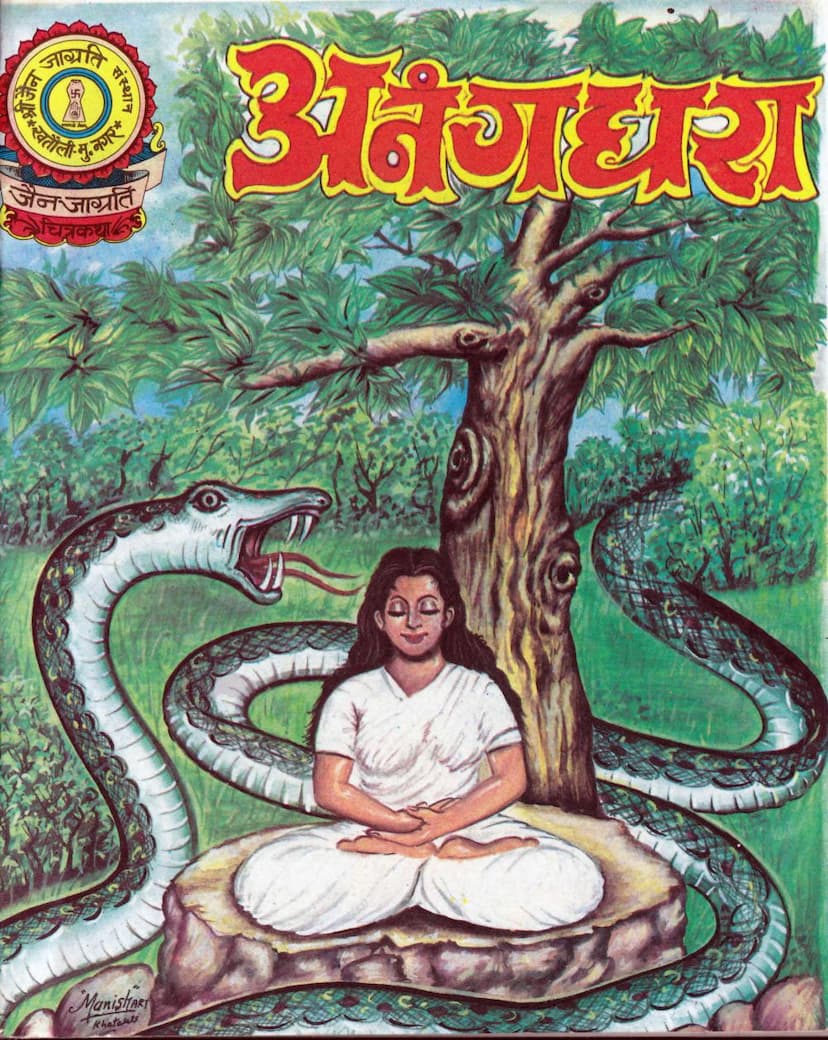Anangdhara
Added to library: September 1, 2025

Summary
This document is a Jain comic book titled "Anangdhara," published by Jain Jagriti Chitrakatha and authored by Veersaagar Jain. The preface states that the story is an inspirational account of Anangdhara, who was the previous life of Vishalya, the wife of Lakshmana, brother of Lord Rama. The story is based on the "Padmapurana" by Acharya Ravishana.
The main message of Anangdhara's life, as highlighted in the preface, is the importance of maintaining virtues like chastity, self-control, and equanimity even in extremely adverse circumstances. Her experience of samadhi-marana (a calm and conscious death) is presented as a powerful inspiration for spiritual seekers to strive for the same. The publisher hopes that if even one person is inspired to practice samadhi-marana after reading the comic, their effort will be considered successful.
The comic then narrates the story:
-
Page 3-6: Anangdhara is born as the beautiful daughter of Emperor Chakradhar and his queen in the prosperous city of Tribhuvana Nand in the country of Pundrik. She is named Anangdhara. Emperor Chakradhar arranges for her education by highly learned scholars, emphasizing the importance of good conduct and virtues. She is taught the core principles of Jainism, including the nature of the soul (jiva) and non-soul (ajiva), the concept of self-created universe, and the path to true happiness through equanimity and detachment.
-
Page 7-8: Anangdhara grows into a beautiful young woman. She learns that true happiness comes from remaining focused on one's true self without attachment or aversion, and maintaining equanimity in all situations.
-
Page 9-12: One day, while in the garden with her friends, Anangdhara is abducted by a Vidyadhara (a celestial being) named Punarvasu, the king of Pratishthanpur. When she refuses to go with him, he forcibly takes her in his chariot. Emperor Chakradhar, upon hearing this, orders his army to rescue his daughter. A battle ensues, and despite being outnumbered, the Vidyadhara manages to escape with Anangdhara. Fearing pursuit, he abandones her in a dense, frightening forest called Shwapada Rokh.
-
Page 13-14: Anangdhara is left alone and distressed in the forest, lamenting her fate. Meanwhile, the Vidyadhara, Punarvasu, experiences a sense of detachment upon realizing the impermanence of worldly pleasures and the consequences of his actions. He seeks spiritual guidance from Muni Drumsen and eventually renounces the world to become a monk himself.
-
Page 15-19: Anangdhara wanders through the harsh forest, enduring hardships like thorns, wild animals, heat, and cold. She reflects on the impermanence of the world and the role of karma. She realizes that suffering arises from one's own ignorance and attachments, not from external factors. She practices equanimity and detachment, meditating on her true self. She engages in intense austerities and spiritual practices for 3,000 years.
-
Page 20-23: After 3,000 years, Anangdhara, now a fully realized soul, is visited by the Vidyadhara Arhdas, who is returning from a pilgrimage. He recognizes her and offers to take her back with him. Anangdhara explains that she has found true fulfillment in her spiritual path and is not interested in returning to worldly life. She then faces a severe test when a giant serpent (ajgar) tries to swallow her. At that moment, Emperor Chakradhar and his army arrive. Anangdhara, displaying profound understanding of the soul's immortality, tells her father not to harm the serpent, as the soul is eternal and cannot be killed. The serpent swallows her whole.
-
Page 24-26: Anangdhara's soul attains the third heaven (third devagati). Emperor Chakradhar, witnessing this, experiences intense detachment and renunciation. He realizes the suffering inherent in the cycle of birth and death and decides to take monastic vows. His 22,000 sons also embrace the path of renunciation. They all receive diksha from Muni Raj. The text emphasizes that true happiness comes from recognizing the soul's true nature, overcoming attachment and aversion, and experiencing one's pure consciousness.
-
Page 27: The comic concludes by stating that Anangdhara's soul is reborn in the city of Ayodhya as Vishalya, the daughter of King Dasharatha. Vishalya's touch has the power to cure diseases, and she eventually marries Lakshmana. The comic also includes information about becoming a supporter of Jain Jagriti Chitrakatha.
-
Page 28: This page lists upcoming comic book titles and promotes the importance of instilling religious values in children through Jain religious schools.
In essence, "Anangdhara" is a Jain comic that uses a past-life story to illustrate core Jain philosophical concepts like karma, detachment, equanimity, the eternal nature of the soul, and the path to liberation (moksha), with a strong emphasis on spiritual resilience and the ultimate triumph of virtue.